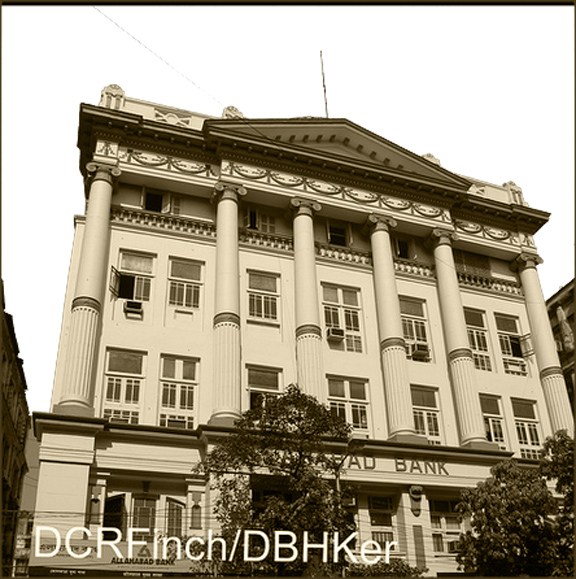 ক্যালকাটা থিয়েটার, অধুনা এলাহাবাদ ব্যাঙ্ক গৃহ, ক্লাইভ রো, লালদিঘী, কলকাতা, ১০০৮
ক্যালকাটা থিয়েটার, অধুনা এলাহাবাদ ব্যাঙ্ক গৃহ, ক্লাইভ রো, লালদিঘী, কলকাতা, ১০০৮
The most important English theatre that inspired foundation of the Bengali Stage – was the Calcutta Theatre, or the New Play House, as it was called to distinguish it from the Old Fort Play House – the first English theatre the city had. The land for it was granted in June 1775 and the construction cost of one lakh Rupee was collected through public subscription. The site had been previously occupied by Mr. Eyre who perished in the siege of Calcutta in 1756, and the new theatre opened sometime in autumn 1776 or little earlier. The maps of Wood 1785-86 and of 1792 by Upjohn spotted this Theatre at the north western corner of Lyon’s Range behind the Writers’ Buildings. The other theatre, the old Play House disappeared by this time.
Between 1776 and 1808, Calcutta Theatre performed many popular farces of its time like, Neck or Nothing; and the musical Entertainment of The Waterman, Barnaby Brittle, with a new musical entertainment called Rule Britannia. Tickets are sold for different sitting types, as for instance, pit and box, sixteen rupees; upper boxes, twelve rupees; gallery, eight rupees. The European community found it a favourite venue for socialization. The theatrical shows apart, they gathered here to dance on its imposing ballroom floor, enjoy excellent drinks and foods served in foyer, or meeting people on business in cordial ambiance as the government officials often did. The theatre hall was as spacious as London’s Bath Theatre, and the standard of shows performed here was comparable to any European stage. To look after the business of Calcutta Theatre, Mr. Barnard Messink was summoned from England to take charge. The Theatre was generally manned by Europeans for works like gate-keeping. The theatre was used for performances until 1808, when the house and adjoining buildings were purchased by a member of the Pathuriaghata Tagore family, Gopimohun Tagore, who added to the buildings and formed the whole of the premises into a bazar, which he called the New China Bazar —subsequently renamed Royal Exchange Place in 1913. See more
Memoirs and travelogues present conflicting descriptions about the location of the Calcutta Theatre. This is mostly because of mixing up details of the Calcutta Theatre and of the Old Fort Play House. Based on reports published in government gazettes scholars however convincingly show that the Calcutta Theatre was situated in 15 Clive Row where the James Finlay, Muir & Co. stayed for a number of years before moving to 21 Canning Street, and thereafter to their own handsome block of buildings erected on the site of old Thieves Bazaar. Presently, the grand building at no.15 Clive Row, previously known as Theatre Street, is occupied by Allahabad Bank as seen in the photograph taken by DBH Ker in November 2008.
Image Source

